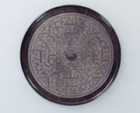Asian Gallery (Toyokan) Room 4
December 4, 2007 (Tue) - March 2, 2008 (Sun)
This display features representative examples of ancient Chinese bronze mirrors from the Museum's collection. Bronze is an alloy of copper, tin and lead and can be either gold or silver. When polished, it is highly reflective, which lead to its worldwide use in mirrors prior to the development of glass mirrors. Bronze mirrors were usually decorated with various designs.
In China, bronze mirrors became widely used during the Warring States period (5th century B.C.-3rd century B.C.). The designs on ancient Chinese mirrors were often of an auspicious nature, which was believed to bring good luck. From the Han dynasty (3rd century B.C. to 3rd century A.D.) on mirrors often bore inscriptions with auspicious words.

